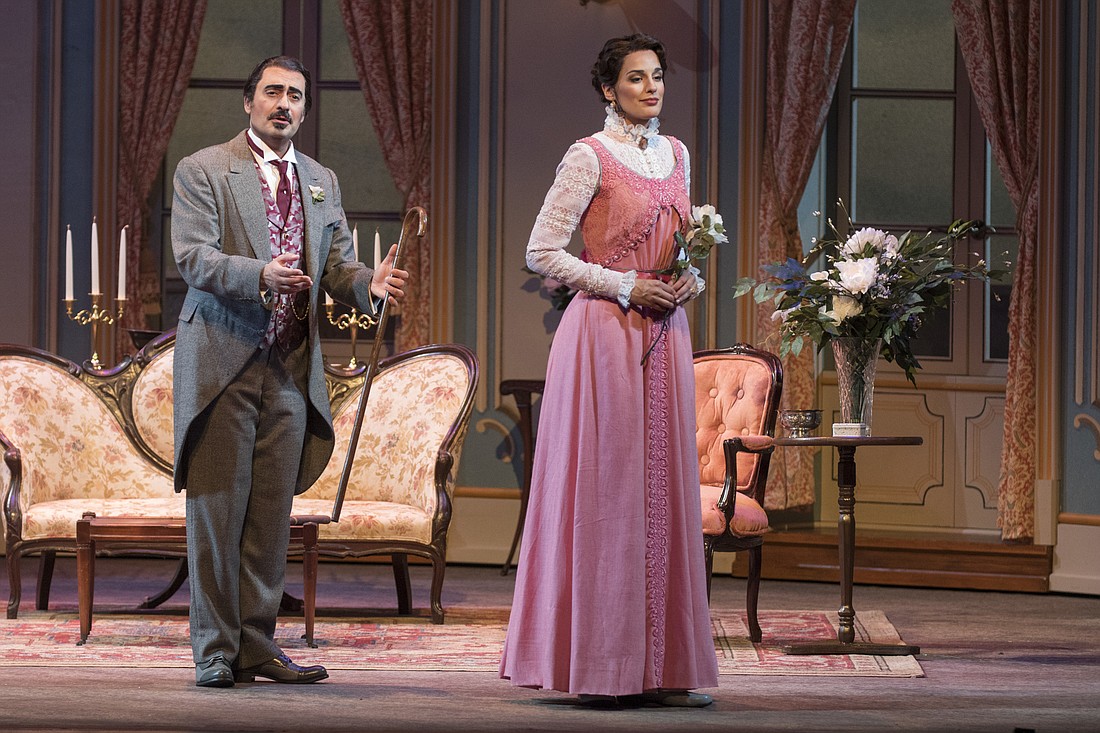- May 10, 2025
-
-
Loading

Loading

“And now for something completely different ... ” The Sarasota Opera’s final offering of its 60th anniversary season is a significant shift from the stage-stretching productions of “Turandot,” “The Magic Flute” and “Nabucco.”
Two one-act operatic comedies, each with only three singers and no chorus, illustrate that effective opera can be produced without large casts and pageantry.
Both Donizetti’s “Rita” and “Il segreto di Susanna” by Wolf-Ferrari present events in married life that are not likely to be encountered today, at least in this form.
“Rita” gives us the situation of a wife, who, thinking her abusive husband died at sea, has married a meeker mate, whom she proceeds to terrorize. The “dead” husband returns, thinking that his wife has also died, and each husband tries to convince the other that he should not be the true husband. True love triumphs in the end with the meek husband becoming more assertive and dominating, while the earlier husband goes merrily on his way, relieved to be out of the situation.
The view that women expect to and should be made to obey is far from a popular one these days, but Donizetti’s tuneful score helps sweeten the bitter edge of the story a great deal.
Elizabeth Tredent was in excellent voice as Rita, the dominating then dominated wife, though her expression of rage and domination seemed limited to a lot of finger wagging and pacing about.
Tenor William Davenport’s Pepé, the beleaguered husband, whose aria was beautifully sung in a lovely lyric style, was equally effective in his transformation to a domineering task master.
And Marco Nisticò as Gasparo created some amusing moments as he and Pepé had various skirmishes, each trying to lose to the other. Always a good performer, his voice sounded a bit dry at the beginning but improved as the evening progressed.
Rita was written to a French libretto, as were a few other operas by Donizetti, but the music is obviously Italian. To have singers singing the French language in Italian style always creates a dichotomy for singers and audience alike. There was a lot of plot exposition in the spoken dialogue, which was also in French. But thanks to the deftly worded projected titles by Stephanie Sundine, the audience was able to follow the story and chuckled and laughed at some of the outdated ideas of marital relationships.
Happily, “Il segreto di Susanna,” translated as “Susanna’s Secret,” brought the evening to a rollicking close. From the sprightly overture of the orchestra with every sparkle intact, to the lyrical arias and duets, the music of Wolf-Ferrari buoys and enhances the dated and paper-thin plot.
And just what is Susanna’s secret? Well, she smokes! While smoking for women or anyone for that matter, is today considered primarily a health hazard, in 1909 when the opera premiered, smoking was something that women of culture just didn’t do.
Golisciani’s libretto has Count Gil, whose wife has been seen out of the house alone, and whose sitting room has a particular smoky smell, convinced that his wife has taken a lover, and he goes to great means to find the guilty party. Of course, Susanna, his younger wife, finally confesses to her habit and offers to cease, but the Count decides instead to take up smoking himself, as all comes to a happy, if not healthy, ending.
This rather improbable plot is aided, abetted and enhanced by the clever direction of JJ Hudson, who provides ample opportunities for the hide-and-sniff antics of all concerned, including a scenery chewing fit of temper by the Count.
Tredent and Nisticò, in the roles of Count Gil and Countess Susanna, seemed more comfortable with this opera than the first, especially with the romantic melodies they were given by the composer, which showed a marked influence of Puccini. Both seemed in better form than earlier in the evening, especially Tredent, whose sumptuous voice seemed made for the role.
In spite of the lovely singing of Tredent and Nisticò, tenor William Davenport in his non-singing role of the servant Sante virtually stole the show with his deadpan demeanor while performing his butler-ish duties or attempting to hide behind curtains. He has an excellent gift for physical comedy, and kept the audience laughing throughout.
I somehow wonder if his name “Sante” is a play on the French word “santé,” meaning health, perhaps a hidden warning in the story. Probably not.
No credit was given for the rural farm-like setting of “Rita,” but the opulent setting for the Wolf-Ferrari was designed by Michael Schweikardt and reminded us of the richness of the early 1900s. Again, Ken Yunker provided excellent lighting and Howard Tzvi Kaplan’s costumes were appropriate in every way.
Conductor Marcello Cormio led well-paced performances of both operas, keeping the ebullient melodies of Donizetti and Wolf-Ferrari alive without overpowering the singers.
All sung and said, this double bill is a fitting addition to this excellent anniversary season of the Sarasota Opera.